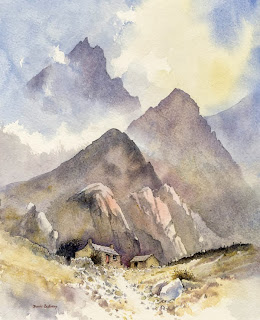Jenny and I have just returned from running a course on Exmoor where we had the luxury of sketching and painting inland scenes as well as the coast. The delightful village of Winsford provided us with a great many stunning subjects, while the heavy rain showers kept things lively. For many the local pub was a life-saver! The following days improved and we had a hot, sunny day at Lynmouth, with a harbour crammed with colourful boats and cottages climbing high up the wooded hillsides.

One of several scenes I tackled was a cottage high up above the harbour, using a graphite water-soluble pencil, and washing over it with a brush afterwards. Behind the cottage rose the wooded hillside. This highlighted the cottage really well, and I rendered it as a mass rather than outline each tree individually. You can discern a slightly darker shape rising above and between the chimneys – this was my sole indication of any sense of shape within the mass. As the cottage was perched above many cottages I decided to vignette the foreground by extending pencil lines downwards, some linked to a hint of vegetation, plus some spatter from the brush after I’d picked up some of the watersoluble graphite on it. This technique is an excellent way to isolate your favourite part of the scene and leave out the bits you don’t want. The only worrying aspect to the sketch for me is the absolutely straight line of the roof – in such a wonky building it would be almost de rigueur to provide the finished painting with a supremely wonky roof ridge line.
Our course was organised by Alpha Painting Holidays run by Matthew and Gill Clark, with whom it is a great pleasure to work. They looked after our every need throughout the course, and we thoroughly recommend them. We still have vacancies on my course in Pembrokeshire from 28th September to 3rd October at the splendid Warpool Court Hotel in St Davids, where we have a wide choice of coastal and inland subjects for all tastes. You can get further details from Warpool Court on 01437 720300 or email info@warpoolcourthotel.com You can also see my website


